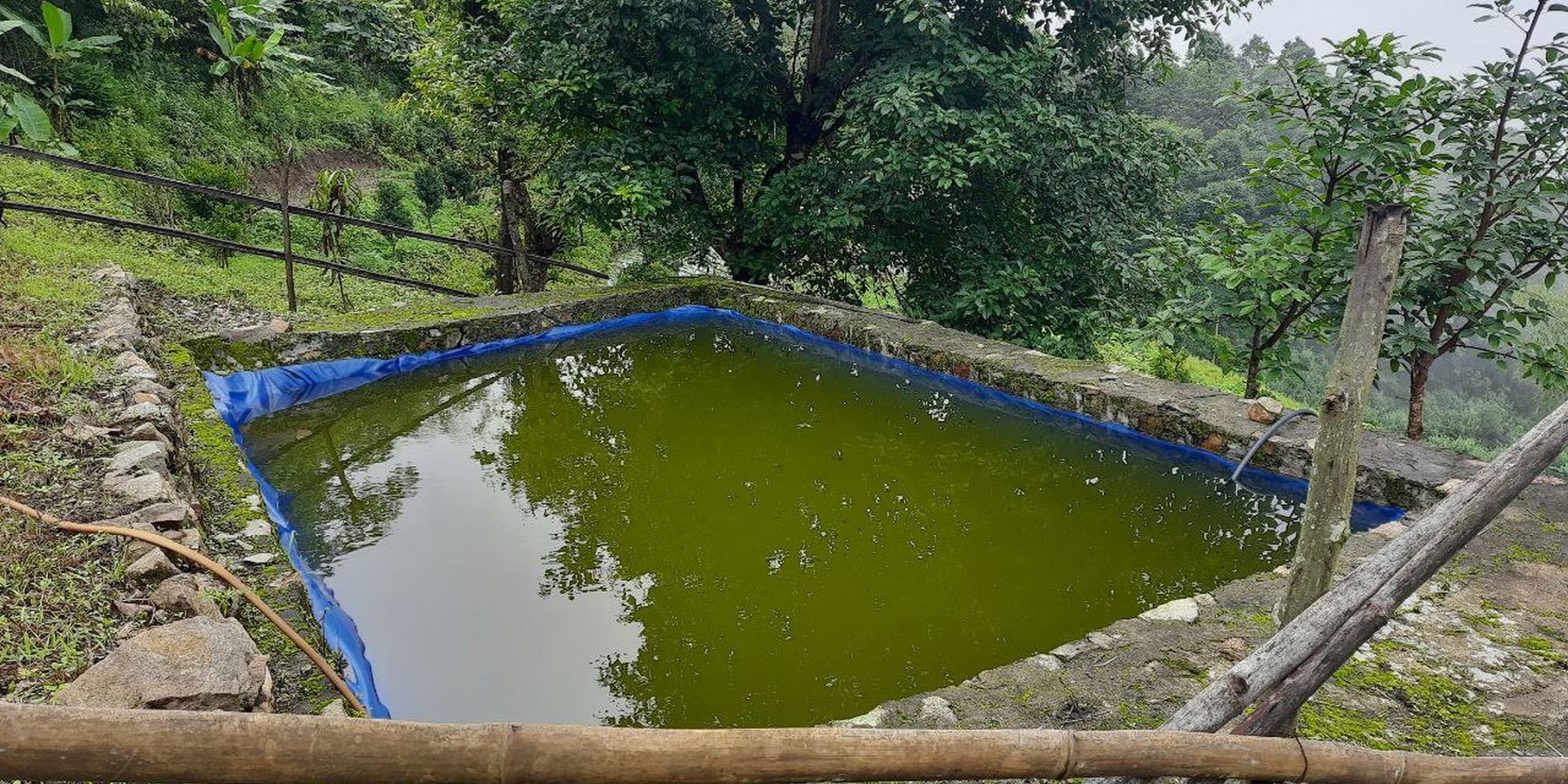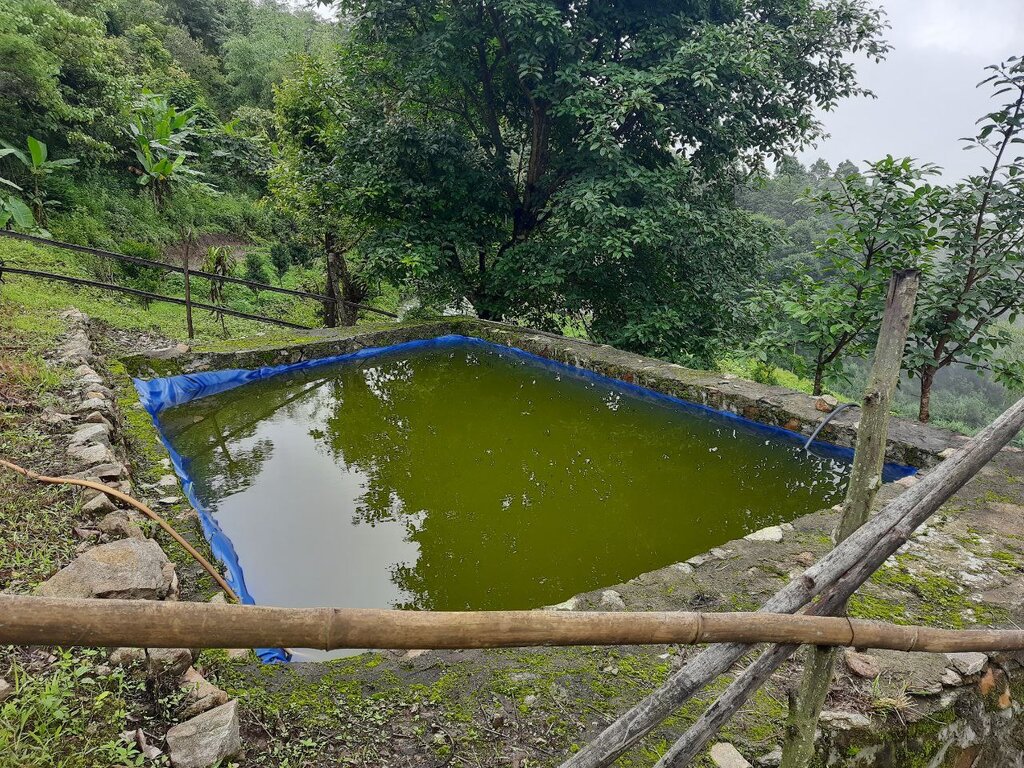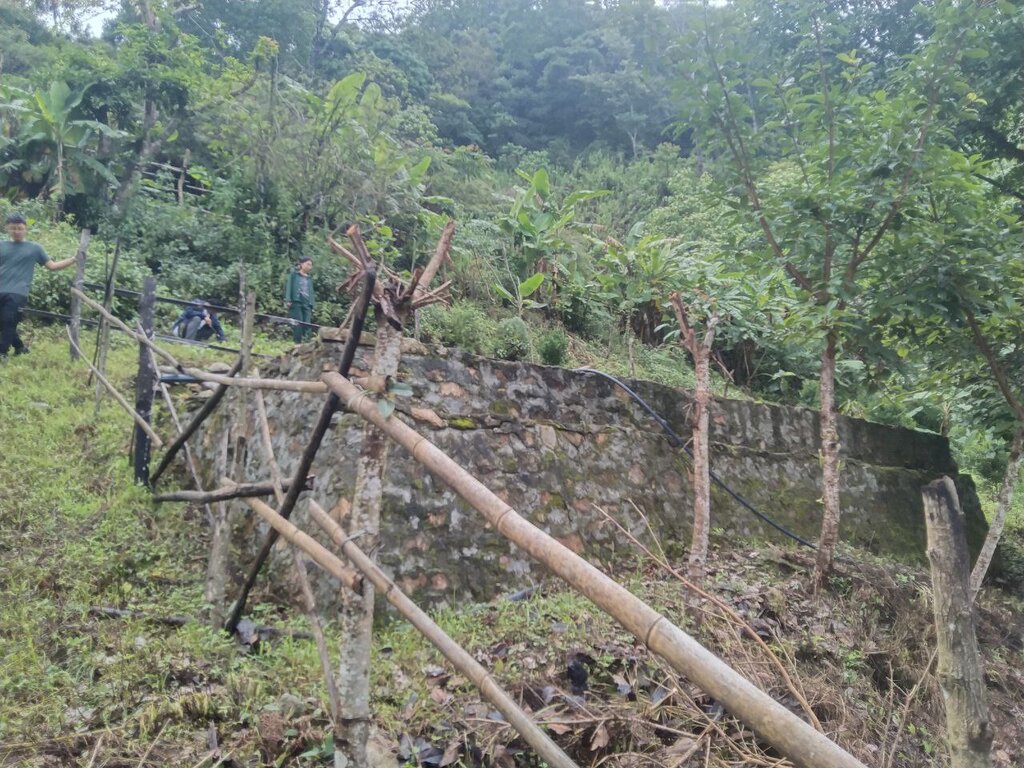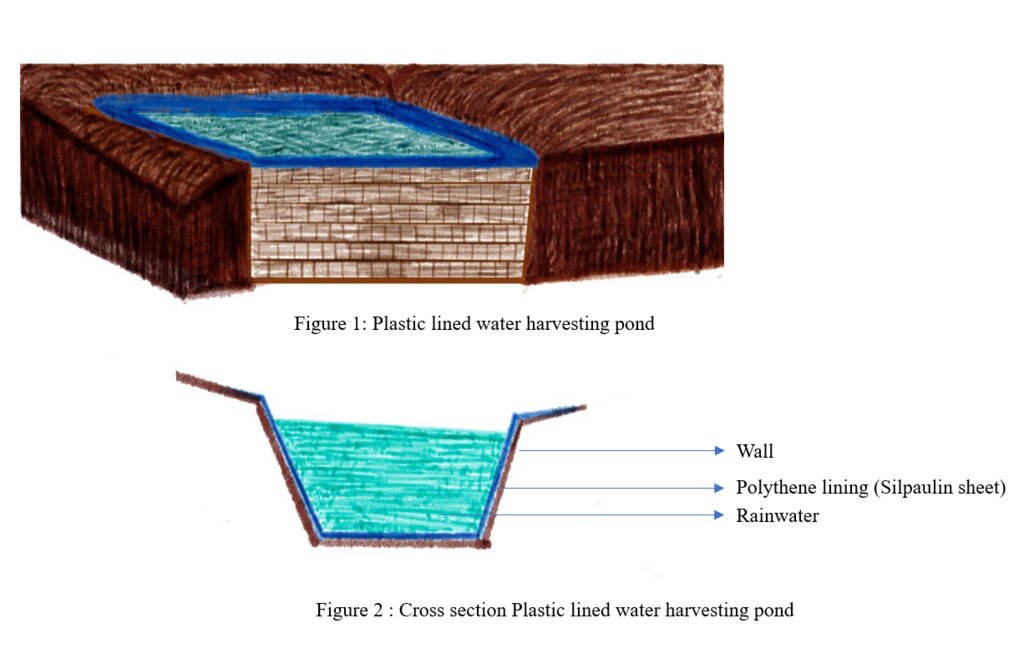Low-Cost Plastic-Lined Water Harvesting Pond [Bután]
- Creación:
- Actualización:
- Compilador: Nima Dolma Tamang
- Editor: Kuenzang Nima
- Revisores: William Critchley, Rima Mekdaschi Studer
Chhu-zing
technologies_6821 - Bután
Visualizar secciones
Expandir todo Colapsar todos1. Información general
1.2 Detalles de contacto de las personas de referencia e instituciones involucradas en la evaluación y la documentación de la Tecnología
Persona(s) de referencia clave
usuario de la tierra:
Sangay
Bután
Nombre del proyecto que financió la documentación/ evaluación de la Tecnología (si fuera relevante)
Strengthening national-level institutional and professional capacities of country Parties towards enhanced UNCCD monitoring and reporting – GEF 7 EA Umbrella II (GEF 7 UNCCD Enabling Activities_Umbrella II)Nombre de la(s) institución(es) que facilitaron la documentación/ evaluación de la Tecnología (si fuera relevante)
National Soil Services Centre, Department of Agriculture, Ministry of Agriculture & Livestock (NSSC) - Bután1.3 Condiciones referidas al uso de datos documentados mediante WOCAT
El compilador y la/s persona(s) de referencia claves aceptan las condiciones acerca del uso de los datos documentados mediante WOCAT:
Sí
1.4 Declaración de la sostenibilidad de la Tecnología descrita
¿La Tecnología aquí descrita resulta problemática en relación a la degradación de la tierra, de tal forma que no puede considerársela una tecnología sostenible para el manejo de la tierra?
No
1.5 Referencia al (los) Cuestionario(s) de Enfoques MST (documentados usando WOCAT)
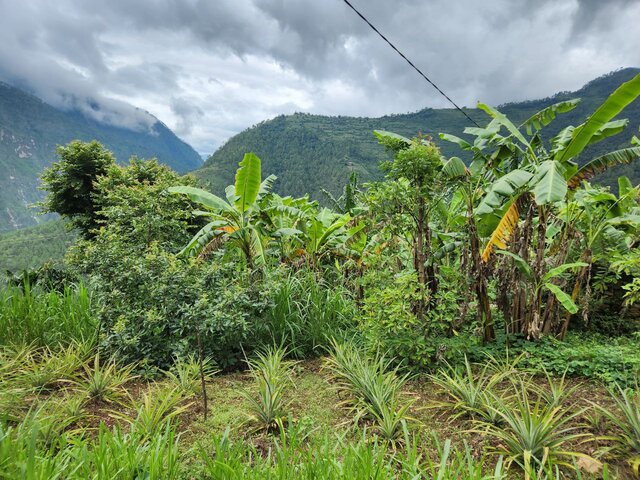
Climate-Smart Village Approach [Bután]
Climate change has become inevitable, and there is a need to address this impending danger. In the Climate-Smart Village (CSV) approach, land users in Ngaru-Pongtang have implemented several technologies and innovations to address climate change impacts, and the programme has worked with 50 households on a total area of 137 …
- Compilador: ONGPO LEPCHA
2. Descripción de la Tecnología MST
2.1 Breve descripción de la Tecnología
Definición de la Tecnología:
Low-cost plastic-lined water harvesting ponds collect and store rain and overland flow water for agricultural and domestic purposes in the dry season. They are both economic and efficient.
2.2 Descripción detallada de la Tecnología
Descripción:
Low-cost plastic-lined water harvesting pond are used to collect and store rain or overland flow water for agricultural purposes in the dry season. They are economic and efficient. These ponds are required in the context of irrigation water shortages. Although rainfall has been projected to be increasing (NCHM, 2017), irrigation water shortage was - and continues to be - one of the major constraints in crop production (IHPP, 2017).
Water from precipitation and surface water sources is lost due to inadequate collection and storage. Villages at the top of the hills, in particular, suffer from acute irrigation as well as drinking water shortages. To tap and collect wastewater, rainwater, and water from other perennial and non-perennial sources, low-cost plastic lined water harvesting ponds are proposed. This water can be used during the dry or “lean” season for agricultural as well as household purposes.
The proposed model pond (plastic sheet size; 9m * 7m) costs less than Nu. 25, 000 (USD 315) for construction but can hold more than 27, 000 litre of water. The same dimension of pond if constructed using concrete, would cost more than Nu. 1, 19, 000 (USD 1500). Furthermore a 10, 000 litre synthetic tank available on the market costs more than Nu.35, 000.
Irrigation water shortage results in fallow lands. It is reported that 6,400 acres (2,600 ha) of irrigable land was left fallow in 2016 and 26 % of the total households surveyed were affected by irrigation water shortages (DoA, 2016). By reducing fallow land and increasing crop production, this technology could be a stepping stone towards food self-sufficiency – as well as providing water for consumption by people and livestock.
Though a similar technology is said to have introduced in the country many years ago, the present form of the technology was introduced to Barshong gewog in Tsirang Dzongkhag by the ‘Himalica’ pilot project in 2014. However, the proposed technology has been modified and improved to suit to the topography and needs of farmers in Bhutan. The proposed pond design is a reverse truncated square pyramid shape unlike the cuboid shape ponds of ICIMOD’s. The pond is designed in such way as to increase pond stability and ease of construction.
Concrete tanks require specific construction methods and faults can develop with ice freezing and expanding in cracks in tank walls during the winter (Slater, 2011). Plastic (silpaulin) sheet lined ponds are leak-proof and primarily depend on the longevity of the plastic sheet unlike concrete tanks. Concrete water tanks, (especially elevated tanks) are also prone to damage due seismic activities (Housner, 1963).
The low-cost plastic lined water harvesting pond adopted is cheap, environmentally friendly, and has positive social impacts. It reduces irrigation water constraints, addresses fallow land problems, and supplements water for domestic purposes. The technology is a tool for reducing poverty, expanding cultivated land and increasing food self-sufficiency resulting in a healthier and happier society.
2.3 Fotografías de la Tecnología
2.5 País/ región/ lugares donde la Tecnología fue aplicada y que se hallan comprendidos por esta evaluación
País:
Bután
Región/ Estado/ Provincia:
Dagana Dzongkhag
Especifique más el lugar :
Pangserpo Chiwog, Drujeygang Gewog
Especifique la difusión de la Tecnología:
- aplicada en puntos específicos/ concentrada en un área pequeña
¿El/los sitio(s) de la Tecnología se ubica(n) en un área de protección permanente?
No
Comentarios:
The technology is located in the land users field.
Map
×2.6 Fecha de la implementación
Indique año de implementación:
2019
2.7 Introducción de la Tecnología
Especifique cómo se introdujo la Tecnología:
- mediante proyectos/ intervenciones externas
Comentarios (tipo de proyecto, etc.):
The technology was initiated by Agriculture Research and Development Centre Bajo through fund support of Food Security and Agriculture Productivity Project of the World Bank. Drujegang, Kana and three blocks of Lhamoidzingkha sub-district of Dagana districts were selected as the project sites.
3. Clasificación de la Tecnología MST
3.1 Propósito(s) principal(es) de la Tecnología MST
- mejorar la producción
- reducir, prevenir, restaurar la degradación de la tierra
- adaptarse al cambio climático/ extremos climáticos y sus impactos
- crear impacto económico benéfico
- crear impacto social benéfico
3.2 Tipo(s) actuales de uso de la tierra donde se aplica la Tecnología
Mezcla de tipos de uso de tierras dentro de la misma unidad de tierras: :
Sí
Especifique el uso combinado de tierras (cultivos/ pastoreo/ árboles):
- Agroforestería

Tierras cultivadas
- Cosecha anual
- Cosecha de árboles y arbustos
Cosechas anuales - Especifique cultivos:
- leguminosas y legumbres - frijoles
- cultivos de raíces/ tubérculos - patatas
- vegetales - verdura de hojas verdes (ensaladas, repollo, espinaca, otros)
- vegetales - otros
- vegetales - vegetales de raíz (zanahorias, cebollas, remolachas, otros)
- chilli, onion
Cultivos de matorrales y arbustos - Especifique cultivos:
- cítricos
Número de temporadas de cultivo por año:
- 2
¿Se practica el intercultivo?
Sí
Si respondió que sí, especifique qué cultivos son intercultivados:
Vegetables intercropped within citrus orchard
¿Se practica la rotación de cultivos?
Sí
Si fuera el caso, especifique :
The land users grow different crops in the same area. For example, if they plant potatoes this year, they plant beans next year.
3.3 ¿Cambió el uso de tierras debido a la implementación de la Tecnología?
¿Cambió el uso de tierras debido a la implementación de la Tecnología?
- No (Continúe con la pregunta 3.4)
3.4 Provisión de agua
Provisión de agua para la tierra donde se aplica la Tecnología:
- mixta de secano – irrigada
3.5 Grupo MST al que pertenece la Tecnología
- cosecha de agua
- Manejo de irrigación: (incl. provisión de agua, invernaderos)
3.6 Medidas MST que componen la Tecnología

medidas estructurales
- S5: Diques, hondonadas, estanques
- S7: Equipo para cosechar agua / provisión de agua/ irrigación
3.7 Principales tipos de degradación de la tierra encarados con la Tecnología

erosión de suelos por agua
- Wt: pérdida de capa arable/ erosión de la superficie

degradación del agua
- Hs: cambio en la cantidad de aguas superficiales
3.8 Prevención, reducción o restauración de la degradación de la tierra
Especifique la meta de la Tecnología con relación a la degradación de la tierra:
- reducir la degradación de la tierra
- restaurar/ rehabilitar tierra severamente degradada
4. Especificaciones técnicas, actividades de implementación, insumos y costos
4.1 Dibujo técnico de la Tecnología
Especificaciones técnicas (relacionadas al dibujo técnico):
Site selection for pond construction:
Choose a site for the pond at the top of the farm for easy flow/use of water to the agricultural fields. Select the site only at the stable soils to avoid collapse, and bursting of the pond. Water sources for the pond may be perennial water sources, rainwater gutter systems, water from tap stand, and waste water from farm house or a combination of the different sources.
Materials required: The materials required for making the pond are:
1.Plastic sheet of desired length and breadth
a.250-300 GSM (gram per square meter)]
b.UV stabilized
2.Measuring tape (30m)
3.Shovel, spade, and crowbar
4.Mosquito net or similar ones
5.HDPE pipes, gates valves
6.Fencing materials (bamboo poles, wooden poles, barbed wire, nails, wire mesh, binding wire)
Procedure to dig the pond:
1.Clear the vegetation and level the ground to construct the harvesting pond.
2.Measure the base length (l), and the base breadth (b) on the leveled ground. These length and breadth will be the length and breadth of the pond floor. Dig out the soil till 1.2 m height (h) to construct a cuboidal pond.
3.From the top edges of the cuboidal pond, measure distance ‘g’ in all four sides. Make slanting cuts from the top to the base on all four sides. Scrap off soils on all sides to obtain slope of 700. The gradient is made for slope stabilization and convenience to lay out plastic sheet.
4.Make the cut surfaces including the floor smooth by using mud and cow dung paste or mud paste in order to avoid damages to the plastic sheet while laying out and when filled with water. The pit ready to lay out plastic sheets should have the dimensions.
5.Carefully lay out the plastic sheet over the pit. Keep an anchor length (overlap) of 0.5m on all sides of the pit. Fix wooden or bamboo pegs or iron rod through the eyelets of the plastic sheet and or cover the overlapping plastic edges by at least 10cm of mud or soil to strongly anchor the plastic sheet.
6.Construct a drain with 30cm width and 30cm depth around the edges of the plastic sheet which was covered with soil or mud. The drainage should slope towards a suitable drain out area.
7.Fence the pond using wire mesh/bamboo/wooden poles/timber to prevent mishaps or accidents. Fill the pond with water only after fencing. Galvanized wire mesh is preferable.
Using water:
Water from the pond can be used in the following ways:
Directly siphoning off with a pipe
Pumping up with a small motor pump
Taking out with suitable containers
Inserting a drain out pipe at one of the base corners.
The insertion of the drain out pipe should be done during the construction of the pond.
Note: The stone wall may be required in specific situations if built in a slope like this one but not generally needed. Technical drawing of the water harvesting pond without the cement structure is available at http://rcbajo.gov.bt/leaflet/ also shared under section 7 of this document.
Autor:
Ongpo Lepcha
Fecha:
08/12/2023
4.2 Información general sobre el cálculo de insumos y costos
Especifique cómo se calcularon los costos e insumos:
- por unidad de Tecnología
Especifique unidad:
water harvesting pond
Especifique las dimensiones de la unidad (si fuera relevante):
41.6 cubic metre
otra / moneda nacional (especifique):
Ngultrum (Nu.)
Si fuera relevante, indique la tasa de cambio de dólares americanos a la moneda local (ej. 1 U$ = 79.9 Reales Brasileros): 1 U$ =:
80,0
Indique el costo promedio del salario de trabajo contratado por día:
Ngultrum 350
4.3 Actividades de establecimiento
| Actividad | Momento (estación) | |
|---|---|---|
| 1. | Surveying and site selection | Anytime |
| 2. | Procuring materials | Anytime after surveying |
| 3. | Construction of pond | Dry season |
| 4. | Fencing | After completion of water harvesting pond |
| 5. | Monitor | Checking water level, infestation of mosquitoes and checking safety measures like fencing and leakages |
4.4 Costos e insumos necesarios para el establecimiento
| Especifique insumo | Unidad | Cantidad | Costos por unidad | Costos totales por insumo | % de los costos cubiertos por los usuarios de las tierras | |
|---|---|---|---|---|---|---|
| Mano de obra | Construction of pond | Person-days | 8,0 | 500,0 | 4000,0 | 100,0 |
| Material de construcción | HDPE pipe | Metre | 100,0 | 40,0 | 4000,0 | 100,0 |
| Material de construcción | Wire mesh | Pieces | 2,0 | 3500,0 | 7000,0 | |
| Material de construcción | Silpaulin plastic sheet | Pieces | 1,0 | 7500,0 | 7500,0 | |
| Material de construcción | Wooden post | Pieces | 14,0 | 60,0 | 840,0 | 100,0 |
| Costos totales para establecer la Tecnología | 23340,0 | |||||
| Costos totales para establecer la Tecnología en USD | 291,75 | |||||
Si el usuario de la tierra no cubrió el 100% de los costos, indique quién financió el resto del costo:
The cost were for plastic sheet and wire mesh and were funded by Food Security and Agriculture Productivity project and Green Climate Fund project.
Comentarios:
Pit digging and laying of plastic sheets were all done manually by the land users. Bamboo used for fencing purposes was available locally. The labour cost was not borne by the land users as they implemented a system of labour-sharing where land users reciprocate by working for an equal number of days at other land users' households as compensation.
4.5 Actividades de establecimiento/ recurrentes
| Actividad | Momento/ frequencia | |
|---|---|---|
| 1. | Construction of concrete wall | Dry season |
| 2. | Monitor | Throughout the year |
| 3. | Maintenance of fence | Annually |
Comentarios:
Due to the unpredictable rainfall patterns and the associated risk of landslides as the pond is located on steep slopes, the farmer was required to reconstruct and reinforce the pond by utilizing cement to provide additional support. Ponds located in the plain or lower gradient do not require support using concrete walls.
4.6 Costos e insumos necesarios para actividades de mantenimiento/ recurrentes (por año)
| Especifique insumo | Unidad | Cantidad | Costos por unidad | Costos totales por insumo | % de los costos cubiertos por los usuarios de las tierras | |
|---|---|---|---|---|---|---|
| Mano de obra | Reconstruction of pond | Person-days | 15,0 | 500,0 | 7500,0 | |
| Material de construcción | Cement (50 kg per bag) | Bag | 10,0 | 400,0 | 4000,0 | |
| Indique los costos totales para mantenecer la Tecnología | 11500,0 | |||||
| Costos totales para mantener la Tecnología en USD | 143,75 | |||||
Si el usuario de la tierra no cubrió el 100% de los costos, indique quién financió el resto del costo:
The cement was supported by the government.
Comentarios:
Boulders and stones used were collected from the land users' field.
4.7 Factores más determinantes que afectan los costos:
Describa los factores más determinantes que afectan los costos:
The most important factors that affect the cost are the construction materials and labour. In this particular situation, cement wall is also one of the major factors affecting the cost although it is not usually required.
5. Entorno natural y humano
5.1 Clima
Lluvia anual
- < 250 mm
- 251-500 mm
- 501-750 mm
- 751-1,000 mm
- 1,001-1,500 mm
- 1,501-2,000 mm
- 2,001-3,000 mm
- 3,001-4,000 mm
- > 4,000 mm
Especifique el promedio anual de lluvia (si lo conoce), en mm:
2000,00
Especificaciones/ comentarios sobre la cantidad de lluvia:
It has an annual rainfall range of 1200-2500 mm
Indique el nombre de la estación metereológica de referencia considerada:
National Centre of Hydrology and Meteorology
Zona agroclimática
- Sub-húmeda
Falls under humid subtropical and dry subtropical zones from the six Agro-ecological zones of Bhutan.
5.2 Topografía
Pendientes en promedio:
- plana (0-2 %)
- ligera (3-5%)
- moderada (6-10%)
- ondulada (11-15%)
- accidentada (16-30%)
- empinada (31-60%)
- muy empinada (>60%)
Formaciones telúricas:
- meseta/ planicies
- cordilleras
- laderas montañosas
- laderas de cerro
- pies de monte
- fondo del valle
Zona altitudinal:
- 0-100 m s.n.m.
- 101-500 m s.n.m.
- 501-1,000 m s.n.m
- 1,001-1,500 m s.n.m
- 1,501-2,000 m s.n.m
- 2,001-2,500 m s.n.m
- 2,501-3,000 m s.n.m
- 3,001-4,000 m s.n.m
- > 4,000 m s.n.m
Indique si la Tecnología se aplica específicamente en:
- situaciones convexas
5.3 Suelos
Profundidad promedio del suelo:
- muy superficial (0-20 cm)
- superficial (21-50 cm)
- moderadamente profunda (51-80 cm)
- profunda (81-120 cm)
- muy profunda (>120 cm)
Textura del suelo (capa arable):
- mediana (limosa)
Textura del suelo (> 20 cm debajo de la superficie):
- mediana (limosa)
Materia orgánica de capa arable:
- elevada (>3%)
Si se halla disponible, adjunte una descripción completa de los suelos o especifique la información disponible, por ej., tipo de suelo, pH/ acidez de suelo, capacidad de intercambio catiónico, nitrógeno, salinidad, etc. :
Moisture content 3.38%, organic matter 4.19%, Organic carbon 2.44%, pH 6.31, electrical conductivity 93.30 µs/cm, nitrogen 0.12%, phosphorus 0.36 ppm, Potassium 301.07 mg/100ml, texture Loamy sand.
The soil analysis was conducted at the Science Laboratory of College of Natural Resources, Royal University of Bhutan, Lobesa, Punakha.
5.4 Disponibilidad y calidad de agua
Disponibilidad de aguas superficiales:
bueno
Calidad de agua (sin tratar):
solo para uso agrícola (irrigación)
La calidad de agua se refiere a:
agua superficial
¿La salinidad del agua es un problema?
No
¿Se está llevando a cabo la inundación del área? :
No
5.5 Biodiversidad
Diversidad de especies:
- mediana
Diversidad de hábitats:
- mediana
5.6 Las características de los usuarios de la tierra que aplican la Tecnología
Sedentario o nómada:
- Sedentario
Orientación del mercado del sistema de producción:
- mixta (subsistencia/ comercial)
Ingresos no agrarios:
- menos del 10% de todos los ingresos
Nivel relativo de riqueza:
- promedio
Individuos o grupos:
- individual/ doméstico
Nivel de mecanización:
- trabajo manual
Género:
- mujeres
Edad de los usuarios de la tierra:
- personas de mediana edad
5.7 Área promedio de la tierra usada por usuarios de tierra que aplican la Tecnología
- < 0.5 ha
- 0.5-1 ha
- 1-2 ha
- 2-5 ha
- 5-15 ha
- 15-50 ha
- 50-100 ha
- 100-500 ha
- 500-1,000 ha
- 1,000-10,000 ha
- > 10,000 ha
¿Esto se considera de pequeña, mediana o gran escala (refiriéndose al contexto local)?
- pequeña escala
Comentarios:
The total area of the farm is 1.8 acres or 0.72 hectares. The average land holding of Bhutan is 3.4 acres, therefore the land users owning less than 3.4 acres are categorized as small-scale.
5.8 Tenencia de tierra, uso de tierra y derechos de uso de agua
Tenencia de tierra:
- individual, con título
Derechos de uso de tierra:
- individual
Derechos de uso de agua:
- comunitarios (organizado)
¿Los derechos del uso de la tierra se basan en un sistema legal tradicional?
Sí
5.9 Acceso a servicios e infraestructura
salud:
- pobre
- moderado
- bueno
educación:
- pobre
- moderado
- bueno
asistencia técnica:
- pobre
- moderado
- bueno
empleo (ej. fuera de la granja):
- pobre
- moderado
- bueno
mercados:
- pobre
- moderado
- bueno
energía:
- pobre
- moderado
- bueno
caminos y transporte:
- pobre
- moderado
- bueno
agua potable y saneamiento:
- pobre
- moderado
- bueno
servicios financieros:
- pobre
- moderado
- bueno
6. Impactos y comentarios para concluir
6.1 Impactos in situ demostrados por la Tecnología
Impactos socioeconómicos
Producción
producción de cultivo
Comentarios/ especifique:
The land users mentioned that there has been an increase in production due to the availability of irrigation water during the dry season.
calidad de cultivo
Comentarios/ especifique:
Improved irrigation water leads to better quality of crops. For example, the leafy vegetables will be flaccid with a reduced total leaf area in the absence of irrigation.
riesgo de fracaso de producción
Comentarios/ especifique:
The availability of water during the critical periods of crop development in dry seasons reduces the risk of production failure.
Disponibilidad y calidad de agua
disponibilidad de agua para ganado
Comentarios/ especifique:
The harvested and stored water from the tank is used to feed the livestock. It is also used to maintain the sanitation of the cattle shed.
disponibilidad de agua para irrigar
Comentarios/ especifique:
The spring water dries in the winter. Therefore, the stored water in the water harvesting tank is available during dry seasons for irrigation.
demanda de agua para irrigar
Comentarios/ especifique:
Trapping the rainwater prevents the utilization of scarce spring water. Therefore, reducing the demand for irrigation from the spring water source.
Ingreso y costos
ingreso agrario
Comentarios/ especifique:
Irrigation plays a significant role in crop cultivation. Therefore, with adequate irrigation water crop production and productivity increase leading to increased farm income.
Impactos socioculturales
seguridad alimentaria/ autosuficiencia
Comentarios/ especifique:
With sustainable sources of irrigation, land users produce enough food for self-consumption increasing food security. Further, the land users sell the produce and generate income with which they can purchase nutritious foods that are not available on the farm.
situación de salud
Comentarios/ especifique:
Water is important to keep the surroundings clean. Therefore, the technology improves the health of the farm household and livestock.
mitigación de conflicto
Comentarios/ especifique:
Using drinking water for irrigation leads to social conflict. However, the issue is resolved with the low-cost plastic-lined water harvesting technology.
Impactos ecológicos
Ciclo de agua/ escurrimiento de sedimento
cantidad de agua
Comentarios/ especifique:
The amount of water available for farm activities is increased as the technology traps overflow and rainwater preventing water wastage.
cosecha/ recolección de agua
Comentarios/ especifique:
The rainwater and overflow water are harvested efficiently preventing runoff and surface erosion.
Biodiversidad: vegetación, animales
control de pestes/ enfermedades
Comentarios/ especifique:
Water harvesting pond acts as a suitable habitat for mosquitoes therefore increasing the risk of malaria.
Reducción de riesgos de desastres y riesgos climáticos
impactos de sequías
Comentarios/ especifique:
The impact of drought on agricultural activity is significantly reduced as the tank increases water availability.
6.2 Impactos fuera del sitio demostrados por la Tecnología
disponibilidad de agua
Comentarios/ especifique:
Reduced spring water requirement in the field is diverted to water availability for other farming communities and wildlife.
6.3 Exposición y sensibilidad de la Tecnología al cambio climático gradual y a extremos relacionados al clima/ desastres (desde la percepción de los usuarios de tierras)
Cambio climático gradual
Cambio climático gradual
| Estación | Incremento o reducción | ¿Cómo es que la tecnología soporta esto? | |
|---|---|---|---|
| temperatura anual | incrementó | bien | |
| lluvia anual | disminuyó | muy bien |
Comentarios:
The technology copes well with the decreasing rainfall as it captures the limited rainwater and makes it available for agricultural use.
6.4 Análisis costo-beneficio
¿Cómo se comparan los beneficios con los costos de establecimiento (desde la perspectiva de los usuarios de tierra)?
Ingresos a corto plazo:
positivo
Ingresos a largo plazo:
ligeramente positivo
¿Cómo se comparan los beneficios con los costos de mantenimiento/ recurrentes (desde la perspectiva de los usuarios de tierra)?
Ingresos a corto plazo:
muy positivo
Ingresos a largo plazo:
muy positivo
6.5 Adopción de la Tecnología
- 1-10%
De todos quienes adoptaron la Tecnología, ¿cuántos lo hicieron espontáneamente, por ej. sin recibir nada de incentivos/ materiales:
- 0-10%
Comentarios:
All the farmers who have adopted the technology were partially funded (external support).
6.6 Adaptación
¿La tecnología fue modificada recientemente para adaptarse a las condiciones cambiantes?
Sí
Si fuera así, indique a qué condiciones cambiantes se adaptó:
- cambios climáticos / extremos
Especifique la adaptación de la Tecnología (diseño, material/ especies, etc.):
The location of the water harvesting technology on slopes presents a risk of potential landslides caused due to climate change effects such as heavy rainfall. Therefore, the structure of the technology was modified to address this issue by providing support using the cemented wall. The modification is suitable for the steep slopes and is not required on the plain areas.
6.7 Fuerzas/ ventajas/ oportunidades de la Tecnología
| Fuerzas/ ventajas/ oportunidades desde la perspectiva del usuario de la tierra |
|---|
| Increased crop production. The technology enables land users to cultivate crops during dry seasons. |
| Increased water availability. The water harvesting pond provides adequate water for livestock rearing, household use and agricultural purposes. |
| Fuerzas/ ventajas/ oportunidades desde la perspectiva del compilador o de otra persona de referencia clave |
|---|
| It is cost-effective compared to a cemented tank. |
| The water harvesting tank constructed using high-quality plastic is durable providing economical benefits. |
6.8 Debilidades/ desventajas/ riesgos de la Tecnología y formas de sobreponerse a ellos
| Debilidades/ desventajas/ riesgos desde la perspectiva del compilador o de otra persona de referencia clave | ¿Cómo sobreponerse a ellas? |
|---|---|
| Risk of accidents leading to the drowning of small children and domestic animals such as dogs. | Constructing a fence around the pond and creating awareness. |
| The technology acts as a habitat for mosquitoes leading to increased malaria infection in the household. | Regular cleaning and removal of sediments, vegetation, algal and plankton growth (serves as a food source for mosquitoes). |
7. Referencias y vínculos
7.1 Métodos/ fuentes de información
- visitas de campo, encuestas de campo
one
- entrevistas con usuarios de tierras
one
¿Cuándo se compilaron los datos (en el campo)?
07/07/2023
7.3 Vínculos a la información relevante disponible en línea
Título/ descripción:
Low cost plastic lined water harvesting pond
URL:
http://rcbajo.gov.bt/leaflet/
Vínculos y módulos
Expandir todo Colapsar todosVínculos

Climate-Smart Village Approach [Bután]
Climate change has become inevitable, and there is a need to address this impending danger. In the Climate-Smart Village (CSV) approach, land users in Ngaru-Pongtang have implemented several technologies and innovations to address climate change impacts, and the programme has worked with 50 households on a total area of 137 …
- Compilador: ONGPO LEPCHA
Módulos
No se hallaron módulos


